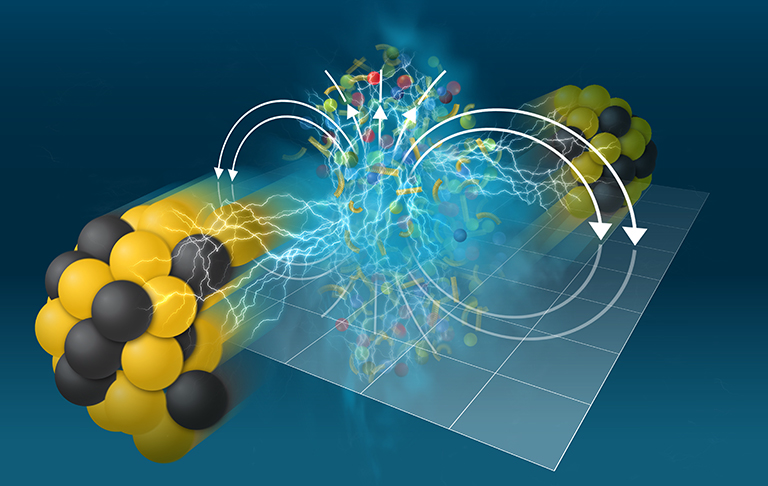Colossal Magnetic Field Detected in Nuclear Matter
Researchers have observed the interaction between a state of matter known as a quark–gluon plasma (QGP) and a magnetic field [1]. This observation of the effects of a magnetic field—which was 1000 times the strength of those on neutron stars—is a step toward a better understanding of the strong nuclear force that holds all of the particles together inside atomic nuclei. It also puts limits on the possible value of the QGP’s electrical conductivity, a property that informs models of the early Universe.
In normal matter, quarks are bound into multiquark particles, mainly protons and neutrons, by the strong nuclear force, which is carried by gluons. But in a QGP, quarks and gluons are free to roam. Microseconds after the big bang, theory predicts that the Universe was filled with a QGP. The early Universe may also have contained large electric and magnetic fields, which would influence the QGP’s motion and affect the structure of the early Universe.
Researchers at the Relativistic Heavy Ion Collider (RHIC) at Brookhaven National Laboratory in New York have been creating QGPs in collisions of pairs of heavy nuclei since 2000. These collisions are never perfectly head-on, so there is often a significant chunk of positively charged nuclear material from each nucleus that moves past the collision zone at high speed, which could generate a fleeting magnetic field as strong as 1018 gauss. (Earth’s field is about 0.5 gauss at the surface.) So RHIC’s nuclear collisions could provide an opportunity to study the interactions between a QGP and a magnetic field. Such studies could shed light on conditions in the early Universe and could also lead to new ways of probing the QGP’s properties to better understand how this exotic material behaves under a wide range of conditions.
To detect this elusive field and its interactions with the QGP, the STAR Collaboration at RHIC collided pairs of gold, ruthenium, or zirconium nuclei at an energy of 200 GeV or gold nuclei at 27 GeV to create QGPs. In each collision, the QGP survives for just 10−23 seconds before the quarks begin forming two- and three-quark particles that ultimately fly into detectors. The researchers compared the angular distributions for detected particles that were positively charged, such as protons, with those for negatively charged particles, such as antiprotons. They saw the pattern of charged-particle deflections expected for a combination of magnetic effects. One of the dominant ones was Faraday induction, in which a magnetic field changes over time—in this case diminishing rapidly—and generates an electric field that can push on charged particles.
The experimental results qualitatively match the 2014 predictions by theorist Umut Gürsoy of the University of Utrecht in the Netherlands [2]. In that work, Gürsoy and his collaborators assumed the QGP to have a conductivity about 500 times higher than ordinary metals such as copper, based on QGP simulations. The consistency between theory and experiment indicates that these assumptions were in the right ballpark, says Gürsoy. An accurate value for QGP conductivity is necessary for models of the early Universe, and it also informs researchers’ fundamental understanding of how the QGP redistributes itself and evolves in time. In addition, the results are consistent with the predicted magnetic field of around 1018 gauss, says STAR Collaboration member Gang Wang of the University of California, Los Angeles.
The strong magnetic field detected by the experiments gives researchers a new parameter to use in studies of phase transitions in nuclear matter, says STAR Collaboration member Diyu Shen of Fudan University in China. Previously, researchers mainly looked at the effects of temperature and mass density in driving such transitions. “With our findings, we can extend the investigation to another dimension, the magnetic field,” Shen says.
The results are an important step for physicists trying to understand the basic laws governing quarks and gluons, says Gürsoy. In QGPs, gluons interact with themselves and with the quarks, creating a “highly correlated system that quickly becomes very complicated,” he says. Consequently, theorists rely on approximate models to make predictions. “Based on these observations, we may be able to extend the theory” by more accurately incorporating electromagnetic interactions, he says.
In future work, the STAR Collaboration will study the QGP–magnetic-field interaction at lower collision energies. Lower-energy collisions generate longer-lasting magnetic fields, so they could result in even stronger signals of the QGP–magnetic-field interaction.
–Sophia Chen
Sophia Chen is a freelance science writer based in Columbus, Ohio.
References
- M. I. Abdulhamid et al. (STAR Collaboration), “Observation of the electromagnetic field effect via charge-dependent directed flow in heavy-ion collisions at the Relativistic Heavy Ion Collider,” Phys. Rev. X 14, 011028 (2024).
- U. Gürsoy et al., “Magnetohydrodynamics, charged currents, and directed flow in heavy ion collisions,” Phys. Rev. C 89, 054905 (2014).






